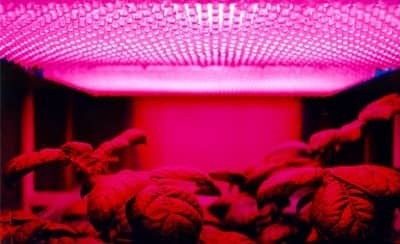Once you start growing vegetables & other plants, you might wonder how to make them grow better. A common question is: Does the color of light affect plant growth?
The color of light DOES affect plant growth, but the effect is more noticeable under low light intensity. Red & blue light are most effective for plant growth, while yellow & green have minimal effect. UV light can damage plants, causing leaves to burn. Growers often use supplemental light to optimize plant growth.
If you’re impatient like me, you can jump to my full article on recommended grow lights for every budget & situation, including:
- the best recommended lower-cost grow light
- best mid-budget grow light
- best high-value grow light for serious growers
What effect does the color of light have on plant growth?
When plants are just seeds and are first sprouting, blue light should be used.
Blue light is very important to the beginning of plant growth because it increases the amount of chlorophyll that is formed.
Some seeds won’t sprout without blue light.
Red light and blue light are important when the plants are mature and beginning to flower.
This helps them produce more leaves and more crops.
Violet light can is used at any point in the plant’s life to enhance the color and taste of a plant.
Understanding visible light and how it relates to plant growth
The light we can see–visible light–is only a tiny fraction of the entire spectrum of electromagnetic energy.
Electromagnetic energy–light–can come in a wide variety of forms.
These include: visible light, gamma rays, infrared light, radio wave, microwaves, x-rays, etc.
While some forms and colors of light are beneficial and even required for plant growth, other forms of light can harm plants.
Here’s a graphic showing how visible light is just a tiny slice of the entire electromagnetic spectrum:
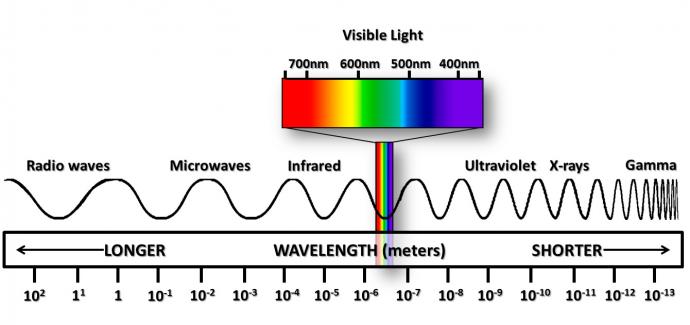
So, why do plants need light?
Simple.
Plants use light to manufacture their own food through photosynthesis.
And chlorophyll–the green pigment in plant leaves & stems– converts carbon dioxide into food using the energy from visible light.
So, wavelengths of visible light are used for plant growth.
But can we adjust or enhance how much light we provide so that our plants grow faster, or healthier?
The short answer is yes.
Oh, and if you’re curious whether plants grow better in sunlight or artificial light, we’ve got an entire article about that.
How does red light affect plants?
Red light is responsible for making plants flower and produce fruit. It’s also essential to a plant’s early life for seed germination, root growth, and bulb development.
Plants need red light because it helps them make chlorophyll, which is the green pigment that absorbs energy from the sun.
This energy is then converted into sugar in the plant’s leaves, which is used to power photosynthesis.
Leaves appear green because the chlorophyll is absorbing all other colors except green.
Find out more about photosynthesis here
In addition to photosynthesis, red light also plays an important role in photosynthetic acclimation—the process by which plants adapt to changes in their environment.
Red light triggers a process called photomorphogenesis, which causes plants to produce protective proteins that help protect them from environmental stresses like cold temperatures or drought conditions.
Red light is good for flowering and fruiting plants.
It has a longer wavelength than blue light, meaning it penetrates deeper into the plant tissue.
Red light is more likely to be absorbed by chlorophyll (a green pigment found in most plants), which plays a role in photosynthesis; red light is also more likely to be absorbed by anthocyanin (a red pigment) that gives many flowers their coloration.
How does red light affect flowering and flavor?
Red light helps plants produce more flowers and fruits because it stimulates the production of anthocyanin.
Anthocyanin is a pigment found in all flowering plants and some non-flowering plants as well.
It gives flowers their coloration and plays an important role in attracting pollinating insects like bees, butterflies, and moths.
The response to red light varies depending on the plant species.
Although strawberries can grow in red light alone, they grow bigger when blue light is also used.
They also taste different depending on how much red or blue light is present.
For most plants, red light is important for growth but should be combined with blue light for optimum results.
How does blue light affect plant growth?
Plants that receive plenty of blue light will have strong, healthy stems and leaves. When the plant absorbs blue light, it triggers the production of more chlorophyll, which leads to stronger stems and leaves. These plants will also produce more sugar than plants exposed to other wavelengths of light because they are receiving more energy from the sun.
Blue light helps plants grow because it’s the most beneficial light for photosynthesis, which is how plants turn energy from the sun into food.
Blue light also regulates the opening of stomata, which are the cell structures on leaves that control the exchange of water and carbon dioxide.
When blue light hits your plants, it causes them to open their stomata.
This allows more CO2 to be absorbed by the plant, making it more efficient at photosynthesis.
The result? Your plant will grow faster and stronger!
Blue light can also have a positive effect on food crops.
In some leafy greens, blue light increases the production of antioxidants and vitamins.
If you are growing these plants indoors, be sure to include blue light in your lighting setup.
To find out more about growing plants with artificial light, check out this article.
As before, the response to blue light varies from one plant to another.
For most plants, blue light is important for growth but should be combined with red light for optimum results.
Why do plants grow best in blue and red light?
Plants are able to make use of only a limited spectrum of the light that is available from the sun.
Blue and red light are particularly effective at promoting plant growth, but in different ways: blue light promotes growth mainly by increasing photosynthesis, whereas red light helps root growth and bulb development.
What this means for you is that if you want your plants to grow as quickly as possible, the best type of lighting for them will be a combination of both blue and red lights.
You can purchase special grow light bulbs for this purpose.
However, if you’re just starting out with indoor gardening and don’t have much money to spare on fancy bulbs just yet, it’s perfectly fine to just use regular incandescent or fluorescent lights in conjunction with each other—the results should still be good enough!
Find out how to make your own DIY grow light here
There are plenty of reasons why a combination of red and blue light is the best way to grow plants indoors.
First off, it’s important to note that not all plants need the same amount of light exposure in order to thrive—different species have different requirements for optimal growth.
But if you’re looking for an easy rule-of-thumb, then using both types will ensure success with almost any type of plant.
When white light, which contains all colors of light, shines on a plant, all of the specific photopigments are activated, since their specialty color is present.
This means the photopigments can all work together to create food for the plant.
Conversely, if one color is missing (particularly red or blue light) then certain photopigments will not be activated and the food-making process will be less efficient for the plant.
For this reason, a combination of red and blue light allows plants to grow best.
Check out our guide to which type of light is best for plant growth.
Quick science lesson on photosynthesis
So we’ve discussed how each color affects plants but I think it’s also important to understand the science behind why the colors affect plants the way they do.
Photosynthesis, chlorophyll, and wavelengths are all factors to consider for how different color lights affect plant growth.
Photosynthesis is the process that plants go through to change light, water and carbon dioxide into glucose and oxygen.
Glucose is a type of sugar and is used as a food for the plants.
The byproduct of photosynthesis is oxygen.
Photosynthesis cannot take place without chlorophyll.
Chlorophyll is what makes plants green and allows plants absorb light energy and turn it into food.
Since chlorophyll is green, colors on the opposite side of the color spectrum are most efficient for plant growth including red and blue.
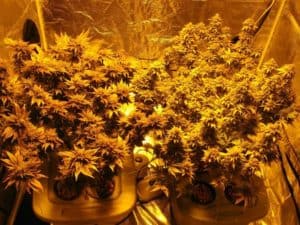
Light is a type of energy and it varies based on the wavelength of the color.
Ultraviolet has the shortest wavelength so it has a higher energy.
Next, in increasing order by wavelength is violet, blue, green, yellow, and lastly red which has the longest wavelength and is least energetic.
This is important when considering which light to use for plant growth.
Since UV light is so energetic, it’s actually harmful to plants.
And since red light is less energetic, it is less effective for plant growth when used by itself.
All this is important to understand how light affect plants.
Without the proper energy from light, plants would not be able to go through photosynthesis and produce food to sustain the plants.
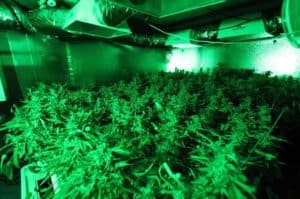
What the heck is DLI, and why should you care?
Commercial greenhouse growers and horticulturalists often look at DLI, since it gives them a benchmark to know who healthy their plants are.
So what exactly is DLI?
Not all light is used by plants for photosynthesis.
Some colors and wavelengths are used differently by plants, and some wavelengths can’t really be used at all.
DLI tells how much light is available to the plant for photosynthesis–which is light in the 400-700 nm range–in other words, visible light.
The more DLI, the more your plants can photosynthesize, and the more they can grow.
Greenhouses, because of the glazing, allow less light for plants.
Researchers from Purdue University and Michigan State University found that supplemental lighting–in other words, grow lights–were the only way to increase DLI in a greenhouse to be able to produce high-quality plants (original article here).
So, to ensure your plants grow optimally, you’ll want to keep an eye on DLI, and how much daily light each type of plant that you’re growing requires.
Out of the colors in the visible spectrum, red and blue are the most important colors for optimal plant health and maximizing plant growth.
Ultraviolet light is actually harmful for plants, and green and yellow light have minimal effects on plants.
Details for each light color and its affect on plant health and growth are listed below.
Ultraviolet Light
Ultraviolet light, also known as UV light, is commonly known as being harmful for humans.
If a human is exposed to too much UV light they will get sunburned and can have other negative effects.
Just like prolonged exposure to UV light is harmful to humans, high-intensity or long exposure to UV light is harmful to plant growth.
The less exposure to UV light, the better your plants will grow.
Violet Light
Violet light is beneficial to plants.
Violet light has a higher amount of energy so when plants are exposed to violet light the plant color, fruit and vegetable taste is enhanced, the plants have a better aroma, and increases the amount of antioxidants that the plant produces.
So overall, violet light helps plant growth, and can be used to protect the plants from damage.
Blue Light
Plants benefit from blue light primarily during the early stages of growing.
Blue light helps with the plant’s production of chlorophyll–the green pigment that traps light energy and is integral to photosynthesis.
In other words, blue light is easier for a plant to absorb and use the energy in photosynthesis.
So, blue light increases plant growth and makes the plant reach maturity faster.
This is why blue light is especially important for seedlings and young plants.
Exposure to blue light can help the seeds germinate, and ensure robust growth for roots, stems, and leaves.
Green Light
Plants absorb many types of light but reflect green light.
This is why plants typically have green leaves.
Mostly green light is used to enhance the production of chlorophyll making the plants greener.
While green light isn’t as integral as red or violet light to plant growth & health, green light can make plants appear greener, and therefore is useful in commercial greenhouses where customers are viewing & selecting plants to purchase.
Yellow Light
Yellow light is similar in its effects on plant growth & health as green light.
The major difference yellow light has as opposed to green light is that, while yellow light doesn’t directly help produce chlorophyll, some studies have shown that removing yellow light from greenhouses may produce healthier plants than growing the same plants outside, where they’re exposed to full-spectrum sunlight.
Red Light
Red light carries less energy than the other colors and is not very effective on its own.
But when combined with blue light, red wavelengths are very helpful for mature plants.
Red light helps flowers bloom.
When combining red and blue light, the amount of leaves that a plant grows is greatly increased.
Specifically, a study by Michigan State University floriculture extension team found that if plants are grown only using red light, they’ll have a stretched, enlongated appearance, and their leaves will become thin and large.
Adding 10-20% blue light allowed plants to grow much healthier, with a compact appearance.
There is also far-red light which is has wavelengths that are lower than normal red light–similar to near-infrared wavelengths.
Far-red light helps the plants produce greater yields.
The far-red light does this by speeding up the process a plant goes through in the night.
During the night is when the flowers ripen.
By speeding up the nighttime process, red light helps produce greater yields for your plants.
Choosing the right light
Although it may be tempting to choose a light that is concentrated on color, plants need to have a bit of each color.
Providing your plants with each type of light will benefit the plants the most.
If you have a higher concentration of blue and red light rather than yellow and green light there will be enhancements in the function of your plants.
Other considerations when choosing a light is how intense the light is and how long the plants are exposed to the light.
Higher intensity increases the amount of photosynthesis the plant goes through.
The duration of light outside is based on the sun, but in a greenhouse, it’s recommended to keep the lights on for 12 to 14 hours per day to achieve the best results.
Recommended grow lights
And here’s a quick summary of different types of lights:
- High intensity discharge lights are used mostly by major growth operations, because they use more electricity and produce more heat.
- Fluorescent lights are longer lasting and produce a lot of blue light. They may not provide the full color spectrum but for leafy plant such as herbs and lettuces they are effective. They are often chosen because they are long lasting, energy efficient, and do not produce a lot of heat.
- LED lights are designed to produce red and/or blue light. They are increasingly popular for hobbyist indoor greenhouses, but they don’t produce very high intensity, so shouldn’t be used for large-scale growth operations.
- Incandescent lights are not ideal for a greenhouse. These are often used for aesthetics and not function. Although they are the cheaper than other types of lights, they don’t provide the needed intensity that plants require.
How Far Should Grow Lights Be From Plants?
Distance from the light to the plant depends on the type of light used:
- High intensity discharge lights: 5 to 8 feet above the plants
- Fluorescent lights: 4 to 6 inches above the plant
- LED lights: 14 to 30 inches above the plants
You can make you own grow light using light boxes, chains, and light bulbs.
The chains are used to adjust the distance the light is from the plant.
As the plants grow you will need to adjust the distance the light is above the plant.
You can bounce over to our full article to find out the recommended LED grow lights distance from plants.
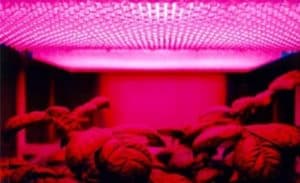
Related questions
Does leaf color affect photosynthesis?
Yes, green leaves have a higher rate of photosynthesis than other colors of leaves because green leaves have more chlorophyll. Plants with predominantly reddish leaves tend to be less productive–in other words, they tend to grow slower and have less biomass that green-leaved plants.
Does light intensity affect plant growth?
Yes, higher intensity light tends to increase the rate of photosynthesis. This is because the higher intensity of light will speed up the reactions needed for photosynthesis to occur. Greenhouse glazing decreases the intensity of light available to plants for photosynthesis, so supplemental lighting is recommended.
Do plants grow under white light?
White light–in other words, full-spectrum light–is what plants normally have available to them, since the sun produces full-spectrum light. Plants grow optimally in natural sunlight, and white light can also be used in a greenhouse, though you might need to experiment to see what type of light works best for the plants you’re growing.
Does green light affect plant growth?
Green light tends to be the least effective for plant growth. You can tell that green light isn’t absorbed by plants because plants appear green–green light is reflected from, rather than absorbed by, plants. That said, green light is still useful for photosynthesis, but isn’t nearly as essential as red or blue light.

